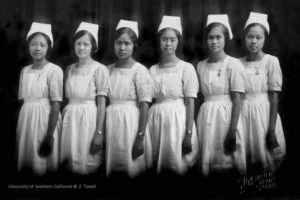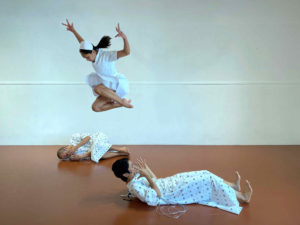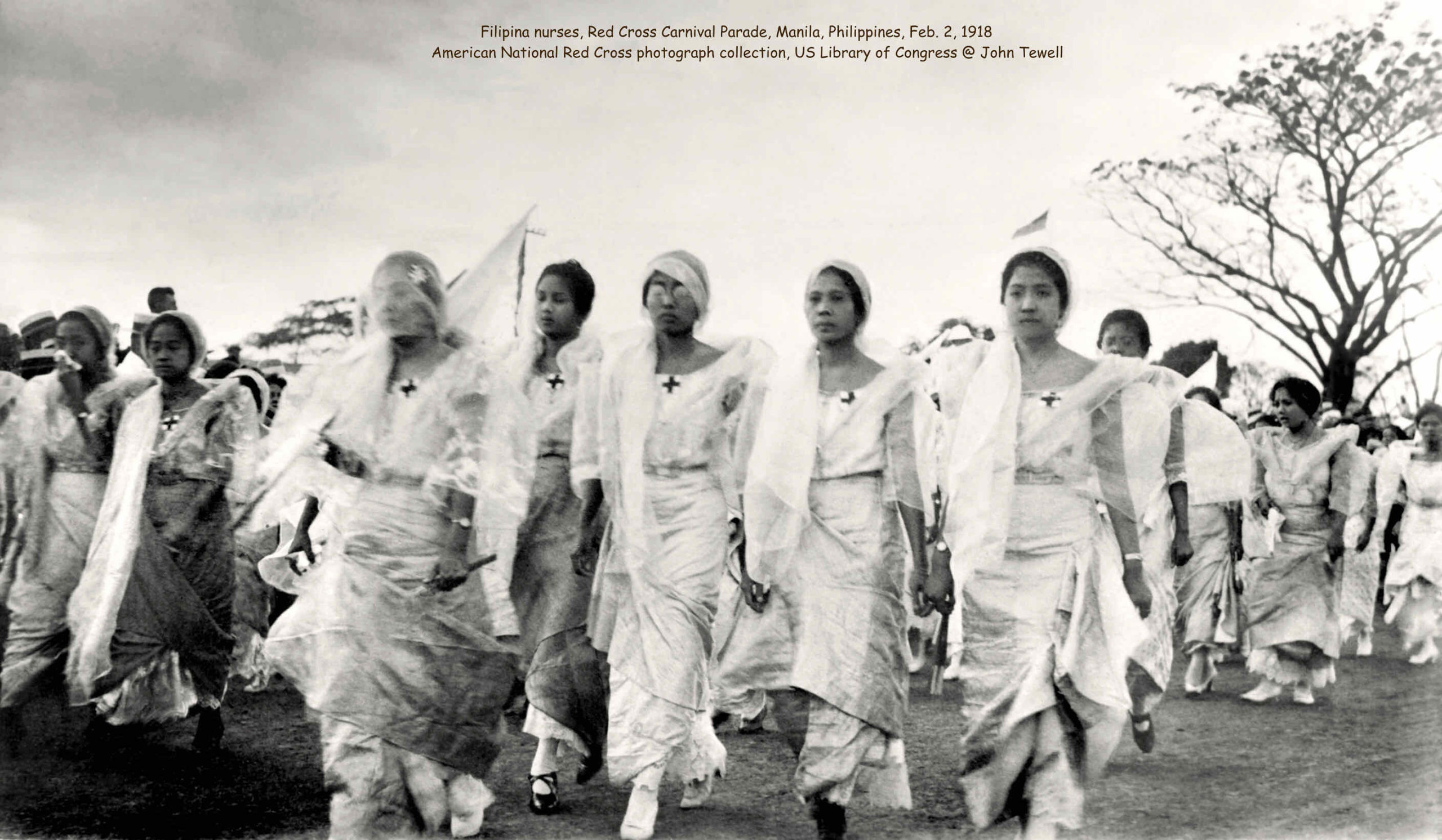Courtesy of American National Red Cross photograph collection US Library of Congress/J. Tewell
[ID: Black & white photo of Filipina nurses, Red Cross Carnival Parade, Manila, Philippines, Feb. 2, 1918. Several women in nursing uniforms march, carrying flags and wearing crosses on their collars.]
“During this pandemic, people are starting to call nurses superheroes. This makes me very uncomfortable. This is our job. We are not heroes.”
– Public Health Nurse, Mylene A. Cahambing, RN, MPH
In California, one out of every five registered nurses (RN) is of Pilipinx descent.[1] These nurses are also disproportionately represented on the front lines: bedside as well as in intensive care units, emergency rooms, nursing homes and long-term care.[2] This situation has left these nurses more vulnerable to COVID-19 and explains why, although they make up only four percent of the overall nursing force in the U.S., approximately one third of the nurses who have died of the virus in the United States are of Pilipinx ancestry.[3]
This critical yet underacknowledged population is now the subject of Alleluia Panis’ new site-specific, immersive dance performance, Nursing These Wounds, which premieres at Brava Theater Center Cabaret, October 21-30, 2022. Panis is the Artistic Director of KULARTS, a San Francisco-based nonprofit that began as Kulintang Arts, Inc., a performance ensemble founded by Panis, along with Robert L. Henry and Marcella Pabros-Clark in 1985. In 1995, KULARTS shifted to the presenting and educational arts organization it is today, with the explicit mission of engaging the public in contemporary and tribal Pilipinx arts and culture.
Panis conceived of Nursing These Wounds as a way to investigate the impact of colonization on Pilipinx health and caregiving through the lens of Pilipinx nursing history.

[ID: Black & white photo of nursing class of 1929, St. Paul’s Hospital, Intramuros, Manila, Philippines. Six women in nursing uniforms are lined up side by side and facing the camera.]
Americans began establishing nursing schools in the Philippines in the early 1900s, during the U.S. occupation and colonization of these islands. Subsequently, any time the U.S. faced nursing shortages, such as after World War II and right now, Pilipinos answered the call. Although the Philippines gained its “independence” in 1946, like other previously colonized states, it continues to be bound in debt to the World Bank, International Monetary Fund and other lending institutions to the tune of about $46 billion. This economic bondage is the root of what keeps the export of Pilipinx labor flowing.[4] “Many of the Pilipinx nurses in the U.S. and other countries were or could have been doctors in the Philippines, but they went into nursing because they could earn substantially more by going abroad than they would have at home as doctors or lawyers,” explains Panis. In this context, the nurse who travels overseas to work becomes a commodity, or product of domestic mass production, bringing money home to the Philippine banks.[5] Part of what Nursing These Wounds explores is this tension between institutional demands and the agency of the nurses themselves.
All of the artists collaborating on Nursing These Wounds are of Pilipinx descent and most of them have relatives and friends who are in the nursing profession. Panis’ sister-in-law is a working nurse in San Diego and her cousin recently retired from a hospital in the Boston area.
Dance artist, educator, and end-of-life doula Frances Sedayao shares that her mother “was a brilliant educator” who came to the U.S. from the Philippines when she was in her late 40s:
The quickest thing for her to make money and support her family was to go back to school and become a CNA [certified nursing assistant]. But with no consideration of the health risks. She suffered from heart and pulmonary disease yet she took on a job caring for others – a circular thing which we also show in the piece – the fine line between being a caregiver and a patient – how delicate that is. My mother died early at the age of 66. She was a natural caregiver and nurturer, but she didn’t prioritize her own health. Or she did the best she could. I really want to honor her in this project.
Another Nursing These Wounds dancer, Dre “Poko” Devis, is a second-generation movement and visual artist of Boholano and Ilocano descent. She has a Lola, or grandmother, on her mother’s side who went to nursing school in the Philippines:
I believe she didn’t really have a choice in that matter. . . .she had dreams to migrate here, because that picture is painted for folks who live there that. . . America is better. . .she had five daughters and she worked her butt off. . . .and eventually moved her whole family. . . .If not for nursing, then I wouldn’t be where I am now and I really hold that dear to my heart. This piece is diving deep into that story and it opens the door for us to really feel into the struggles of that work and the great, great strength one must have to do that kind of care.
So how to translate all of these stories into movement?
Jess DeFranco is a dancer and dance teacher who was first introduced to Panis’ work when she saw Man@ng is Deity last year at ODC Theater: “I was blown away. . . .I just kind of fell in love, so when they put out a call for dancers, I sent in my information and now I’m working with the Nursing These Wounds project!”

[ID: Two dancers in hospital gowns on the floor, one on his side with his knees to his chest, the other with head raised and arms and knees bent in distress. A third dancer jumps above them with her knees close to her body and looking down at the others. She is dressed in white with a nurse’s cap.]
One thing DeFranco loved so much about Man@ng is Deity is Panis’ contemporary choreographic approach. In “Embodied Indigeneity: Translating Tradition for the Philippine Contemporary Dance Stage,” Regina Bautista describes the contemporary methodologies of several choreographers based in the Philippines. But what she describes also applies to Panis’ work in the U.S.; that it is “a negotiation and exploration of the possibilities of performing Philippine dance beyond the constraints of tradition and authentic representation.”[6]
“Where we do phrases and sections that call upon Filipino folk dance,” DeFranco says, “I was kind of able to get back to my roots a little bit and get access to a style of dance that I never had the opportunity to study before.” Sedayao adds that when she was growing up in Fremont, nobody there was teaching pre-colonial Pilipinx dance, “which is what I was interested in. So working with Manay[7] I am able to learn bits and pieces of the pre-colonial dances – like now in my 40s.”
The nine dancers in Nursing These Wounds all come with various movement and performance training: hip-hop, ballet, modern, contemporary, gymnastics, martial arts, and theatre.
“With KULARTS,” says Devis, “I feel like the movement is so unique in that it’s rooted in what our bodies can do, and I feel like Manay really understands that.” DeFranco adds, “She spends time really explaining her vision and what the energy is supposed to feel like.” In this way, Panis does what Bautista describes as, “keeping the embodiment of movement systems and gestures as relevant and significant to the new bodies who perform it.” Bautista also asserts that this is an inherently decolonial praxis as opposed to, say, dictating particular movements onto the dancers’ bodies without any possibility of negotiation. “Exploring such possibilities in performing Philippine dance,” she explains, “continuously becomes a critical pursuit,” where the practitioner is challenged to deconstruct and recontextualize “traditional” or indigenous symbols – as opposed to simply appropriating them – to create choreography that expresses the particular Pilipinx identities and/or stories being addressed in a given performance.[8]
Panis’ impact on the field of dance has been recognized by many entities, including Dance/USA, the Wallace Alexander Gerbode Foundation, and the San Francisco Arts Commission which awarded her their inaugural Legacy Artist Grant in 2017.
Panis’ Western dance education began when she attended Galileo High School in San Francisco. A friend took her to an afterschool program in North Beach that was led by a former Denishawn dancer, Klarna Pinska. She went on to study with other teachers, including Alonzo King and Ed Mock. Panis also joined the collective movement of artists of color in the 1970s and ‘80s, collaborating with artists like: the Asian American Dance Collective, Halifu Osumare, June Watanabe, and Jill Togawa. Working with the Bagong Diwa Dance Company between 1974-1982, however, is the work Panis describes as being most “dear to my heart, because it was the beginning of my choreographic career.” Inspired by the Alvin Ailey American Dance Theater, Bagong Diwa was ethnically diverse in composition, but its focus was on work in the Pilipinx American experience.
Today, Panis’ work is part of a current movement among women and queer choreographers of color like Ananya Chatterjea, Jawole Willa Jo Zollar, Dohee Lee, Amara Tabor Smith and NAKA Dance Theater who approach dance wholistically. Their works draw on their ancestry to make a kind of cultural, socio-political and spiritual sense that decolonizes to heal. In this way, the dance functions as medicine.

[ID: Two dancers wearing hospital scrubs in shades of blue-green. One with long dark hair lifts the other from behind in a seated position high up toward her shoulder.]
Another theme Nursing These Wounds explores is the fissure between traditional Pilipinx and Western conceptions of well-being. In my role as dramaturg for this piece, I spoke with several nurses who called for the use of ancestral medicine in general, and also particularly to help nurses with burnout.
And the burnout is dire.
I wanted to speak with more nurses in the Philippines and other countries, but the time difference combined with the crisis situation of the pandemic presented a real barrier. I was told by nurses in the Philippines and the U.S. that they were working double 12 to 16-hour shifts. At the same time, this was not a new phenomenon. Many younger nurses told me stories of their elder relatives working this same amount in order to support their families. Sedayao’s mother is unfortunately not alone in terms of the negative impact of the work on her own health. Dr. Claire Valderama-Wallace, Assistant Professor in the Department of Nursing at California State University East Bay and Chairperson of GABRIELA Oakland, also cites the urgent need “to uproot racism from nursing education,” pointing out that Black, Latinx, and Pilipinx baccalaureate nursing students currently have the highest attrition rates in California.[9] I spoke with nurses who quit the profession because of racist bullying. I spoke with nurses who quit because of corporate greed. One such person is Bryan Philip Cruz, an emergency room nurse who quit after he contracted a severe case of COVID-19 after being supplied with one mask to use per week.
At the same time, Cruz also said, “I wouldn’t trade my experience.” What was clear and consistent across all the conversations I had with Pilipinx nurses was a deep sense of recognition, love and respect for nursing and for each other. “It’s an honorable profession,” says Mylene Cahambing, the public health nurse quoted at the beginning of this piece: “I’m honored to be in this profession, but where is our healing space?”
Ritchel Gazo, a pediatric nurse at Kaiser who is also the Executive Director of Parangal Dance Company says, “We put up a really good image in front of everybody that we’re okay, but in all honesty we aren’t. I think it comes down to really doing a lot of self-care during this pandemic and just being honest with yourself and giving yourself that moment to let that pressure cooker out, release some of that hurt, that grief and anything you’re processing.” Dancing is part of how Gazo stays balanced.[10]
Sedayao noted that playing the part of a nurse in Nursing These Wounds is “funny” in the sense that she is finally performing her parents’ expectation, but in her own way that departs from the intergenerational expectations that were dictated by the colonial capitalist global economy. “I’m looking up to the heavens saying, ‘Ok, I can be a nurse for you.’ And it’s just so nice to work with someone who tells stories of my people in a way that is really thoughtful and genuine. . . . That in itself is such a gift and an inspiration to me, and it makes me feel like home. I’m learning something about my family and I’m speaking and moving with people that have that innate understanding of the struggle and the joys of being Filipino.”
***
KULARTS presents the World Premiere of Nursing These Wounds
Directed and Choreographed by Alleluia Panis
Oct 21-30 at Brava Theater Center Cabaret in San Francisco. Tickets available at https://bit.ly/ntwbrava
[1] Spetz, Joanne, Lela Chu, Matthew Jura, and Jacqueline Miller. “California Board of Registered Nursing 2016 Survey of Registered Nurses.” California Board of Registered Nursing.
[2] Lagnado, Lucette. “A Sisterhood of Nurses.” Wall Street Journal. Aug. 11 2018. <https://www.wsj.com/articles/a-sisterhood-of-nurses-1533992461>.
and
“Online Memorial Honors Filipino Health Care Workers Who Have Died Of COVID-19.” NPR. Aug 1 2020. <https://www.npr.org/2020/08/01/898099601/online-memorial-honors-filipino-health-care-workers-who-have-died-of-covid-19>.
[3] “Sins of Omission: How Government Failures to Track Covid-19 Data Have Led to More Than 3,200 Health Care Worker Deaths and Jeopardize Public Health.” National Nurses United. Mar. 2021.
[4] Choy, Catherine Ceniza. Empire of Care: Nursing and Migration in Filipino American History. Durham: Duke University Press, 2003, 88.
[5] Choy, 116.
[6] Bautista, Regina. “Embodied Indigeneity: Translating Tradition for the Philippine Contemporary Dance Stage.” 2017. York University. Master of Arts Thesis, 161.
[7] In Tagalog: a respectful term of address for a woman older than oneself; like “elder sister.”
[8] Bautista, 161.
[9] “Nurses in the Diaspora.” KULARTS panel discussion. 21 Mar. 2021. <https://www.youtube.com/watch?v=8F-Lueqc6zA>.
[10] Ibid.
This article appeared in the Fall 2022 issue of In Dance.


